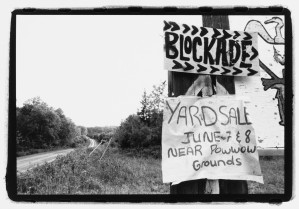Charges against Grassy Narrows trapper dropped
The Crown has dropped all charges against Roberta Keesick, a Grassy Narrows trapper charged for building a log cabin on her family's traditional lands without a permit. Similar charges against her non-native partner and helper, have also been dropped. The cabin building is part of a process of reclamation and revival for Grassy Narrows where people are using the land on their territory to empower themselves and to sustain their families, revive their culture and heal their community.
Read the press release here
Original Call for Support for Roberta Keesick
In early June, 2008 news that Grassy Narrows First Nation’s demand that industrial logging on their territory stop was met when Abitibi-Bowater announced that they would not be seeking a licence in the Whiskey Jack Forest. However the struggle is not over. While the chainsaws have stopped at Grassy Narrows for now, persecution of those that assert their traditional rights on the land has not ended.
Roberta Keesick, a Grassy Narrows clan mother, trapper, blockader, and grandmother, is facing charges in Red Lake Ontario for building a trappers' cabin on her traditional family lands without a Provincial permit. She has been a tremendous force in the grassroots struggles at Grassy Narrows to reclaim traditional land and to assert the right of self determination. The act for which she now faces criminal charges is part of a process of reclamation and revival for Grassy Narrows where people are using the land on their territory as their ancestors have for generations; it is a critically important piece of the work that is being undertaken by the people of Grassy Narrows to empower themselves and to sustain their families, revive their culture and heal their community—this access to land is crucial for the healing of First Nations, and it is this right that is being challenged by the court with the charges that have been brought against Roberta Keesick.
The assertion of rights on traditional land is one of the most important components of the ongoing struggle for Indigenous rights. This case has the potential to set an important precedent; Indigenous people have a right to traditional land use on their traditional territories. This case represents an example of the way that governments prevent First Nations from sustaining and empowering themselves. Roberta Keesick’s actions—the building of a trapping cabin on her own family’s trap line—is a perfect example of how people from Grassy Narrows are asserting their rights through the straightforward actions of living an Anishnabe life. It is of the utmost importance that any and all of us who are concerned with Indigenous rights and the well being of First Nations communities, support the grassroots struggles at Grassy Narrows and in other communities and to support Roberta Keesick in her struggle to simply live her life on her land.





